Themed collection Single-Atom Catalysis

Recent progress and perspectives on single-atom catalysis
Zhiqun Lin, María Escudero-Escribano and Jun Li introduce the Journal of Materials Chemistry A themed issue on single-atom catalysis.

J. Mater. Chem. A, 2022,10, 5670-5672
https://doi.org/10.1039/D2TA90050E
CO2 electrochemical reduction on metal–organic framework catalysts: current status and future directions
The versatility of MOFs is ideal for designing efficient CO2RR electrocatalysts, yet their poor stability and conductivity needs to be improved.

J. Mater. Chem. A, 2022,10, 5899-5917
https://doi.org/10.1039/D1TA10440C
Spatially resolved and quantitatively revealed charge transfer between single atoms and catalyst supports
The direction and spatial distribution of charge transfer between a single atom and its support are key factors for SAC performance.

J. Mater. Chem. A, 2022,10, 5889-5898
https://doi.org/10.1039/D1TA08353H
Single-atom-based catalysts for photoelectrocatalysis: challenges and opportunities
This perspective outlines recent advances, future opportunities and challenges in the research field of single-atom-based catalysts (SACs) in the photoelectrocatalytic (PEC) system.

J. Mater. Chem. A, 2022,10, 5878-5888
https://doi.org/10.1039/D1TA08252C
In situ visualisation and analysis of dynamic single atom processes in heterogeneous catalysts
Heterogeneous chemical reactions catalyzed over solid surfaces at operating temperatures are used to produce a vital part of energy, food, healthcare products, cleaner environments and chemicals.
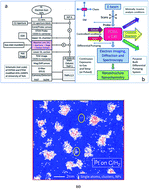
J. Mater. Chem. A, 2022,10, 5850-5862
https://doi.org/10.1039/D1TA08307D
Single-atom catalysts: stimulating electrochemical CO2 reduction reaction in the industrial era
Carbon monoxide and formic acid play a significant role in industrial processes and are exceedingly economical C1 products in electrochemical CO2 reduction reactions (ECR).

J. Mater. Chem. A, 2022,10, 5863-5877
https://doi.org/10.1039/D1TA07778C
Strategies for boosting the activity of single-atom catalysts for future energy applications
Scaffolds in the graphic indicate active sites of SACs. Ideal active sites come from a tenon-and-mortise structure and highlight that the most active SACs require various strategies to achieve synergy, building on a foundation of mutual promotion, restriction, and balance.
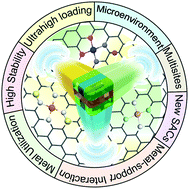
J. Mater. Chem. A, 2022,10, 10297-10325
https://doi.org/10.1039/D2TA00747A
Advances in studies of the structural effects of supported Ni catalysts for CO2 hydrogenation: from nanoparticle to single atom catalyst
The significant structural effects of supported Ni catalysts from nanoparticles to single atoms on CO2 hydrogenation were summarized.
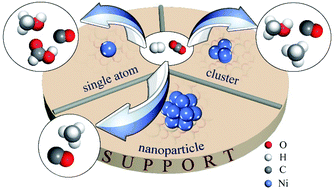
J. Mater. Chem. A, 2022,10, 5792-5812
https://doi.org/10.1039/D1TA09914K
Stability of single-atom catalysts for electrocatalysis
The recent advances in the stability of SACs, including the selection of metals and supports, synthetic strategies, and the catalytic stability in electrocatalysis.
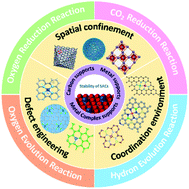
J. Mater. Chem. A, 2022,10, 5835-5849
https://doi.org/10.1039/D1TA08582D
Support-based modulation strategies in single-atom catalysts for electrochemical CO2 reduction: graphene and conjugated macrocyclic complexes
An overview of two types of SACs for the CO2RR and the corresponding strategies to regulate the catalytic activity.
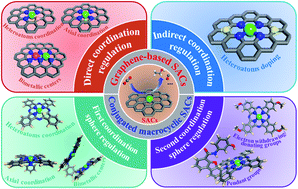
J. Mater. Chem. A, 2022,10, 5699-5716
https://doi.org/10.1039/D1TA09069K
Synchrotron-radiation spectroscopic identification towards diverse local environments of single-atom catalysts
The unique structures of single-atom catalysts (SACs) endow them with widespread energy applications. This review summarized the achievements of multifarious synchrotron-radiation characterization methods in studying the local environments of SACs.

J. Mater. Chem. A, 2022,10, 5771-5791
https://doi.org/10.1039/D1TA08254J
Mechanistic understanding and design of non-noble metal-based single-atom catalysts supported on two-dimensional materials for CO2 electroreduction
This review delivers an overview of non-noble metal-based single-atom catalysts (SACs) for CO2RR and provides insights into mechanistic understanding from different aspects.

J. Mater. Chem. A, 2022,10, 5813-5834
https://doi.org/10.1039/D1TA08337F
Polyoxometalate-based materials: quasi-homogeneous single-atom catalysts with atomic-precision structures
This perspective provides an overview and outlook of polyoxometalate-based single-atom catalysts with atomic-precision structures and wide-ranging functionalities, including isolated POM clusters, POM-based assemblies, and supported POM structures.

J. Mater. Chem. A, 2022,10, 5758-5770
https://doi.org/10.1039/D1TA08577H
Synergistically enhanced single-atomic site catalysts for clean energy conversion
This review highlights several important electrocatalytic reactions performed over single-atomic synergistic structures, including SAC-nanoparticles (SAC-NPs), SAC-clusters (SACCs), dual-atom sites (DACs), and single-atomic alloys (SAAs).
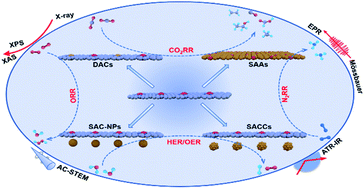
J. Mater. Chem. A, 2022,10, 5673-5698
https://doi.org/10.1039/D1TA08561A
Single atoms supported on metal oxides for energy catalysis
Single-atom catalysts (SACs) have attracted wide interest from researchers, as they promisingly bridge the gap between homogeneous and heterogeneous catalysts.
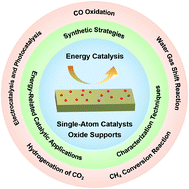
J. Mater. Chem. A, 2022,10, 5717-5742
https://doi.org/10.1039/D1TA08016D
Single-atom catalysts for thermal- and electro-catalytic hydrogenation reactions
The review highlights recent advances and remaining challenges in single atom catalysts for thermal- and electro-catalytic hydrogenation reactions.

J. Mater. Chem. A, 2022,10, 5743-5757
https://doi.org/10.1039/D1TA07910G
The bifunctional volcano plot: thermodynamic limits for single-atom catalysts for oxygen reduction and evolution
Based on the “bifunctionality index”, which can be both measured and calculated, we elaborated a joint volcano plot for O2 reduction and evolution. The plot shows how scaling relations limit the bifunctional performance of single-atom catalysts.

J. Mater. Chem. A, 2022,10, 5937-5941
https://doi.org/10.1039/D1TA08366J
Pyrolysis-free synthesis of single-atom cobalt catalysts for efficient oxygen reduction
A single-atom Co-PTS-COPs@MWCNT catalyst was crafted via a simple yet robust pyrolysis-free approach for high-efficiency oxygen reduction.
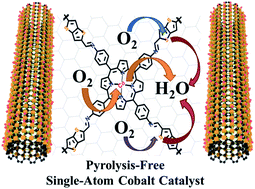
J. Mater. Chem. A, 2022,10, 5918-5924
https://doi.org/10.1039/D1TA08412G
Nitrogen-coordinated single-atom catalysts with manganese and cobalt sites for acidic oxygen reduction
Improved catalytic durability towards acidic oxygen reduction reaction is achieved by using a Pt-free and Fe-free single-atom catalyst based on Mn, Co and N co-doped carbon (MnCo–N–C), compared with a Co and N co-doped carbon (Co–N–C) catalyst.

J. Mater. Chem. A, 2022,10, 5930-5936
https://doi.org/10.1039/D1TA08029F
Hierarchical 3D porous carbon with facilely accessible Fe–N4 single-atom sites for Zn–air batteries
The prepared SA-Fe-3DOMC catalyst with rich pore structure and densely accessible Fe–N4 active was demonstrated to boost ORR catalytic performance and peak power density for Zn–air batteries.

J. Mater. Chem. A, 2022,10, 5925-5929
https://doi.org/10.1039/D1TA08050D
A covalent organic framework with electrodeposited copper nanoparticles – a desirable catalyst for the Ullmann coupling reaction
Electrochemical deposition from an electrolyte containing Cu2+ loads Cu(0) nanoparticles (3.34 wt%) into a COF, making them resemble a single-site catalyst. This Cu@COF serves as an excellent heterogeneous catalyst for multi-fold Ullmann coupling reactions.
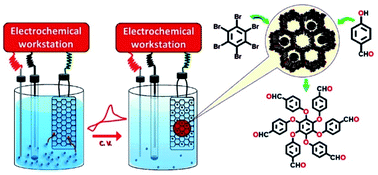
J. Mater. Chem. A, 2022,10, 15647-15656
https://doi.org/10.1039/D2TA01326F
Pure silica-supported transition metal catalysts for the non-oxidative dehydrogenation of ethane: confinement effects on the stability
All-silica MFI zeolite was used as a support for the synthesis of promoter-free robust transition metal catalysts. Effects of different physical parameters and catalyst deactivation mechanism were studied for the ethane dehydrogenation reaction.
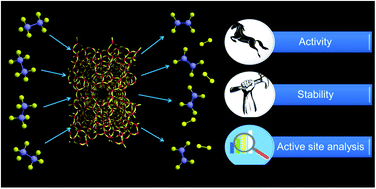
J. Mater. Chem. A, 2022,10, 9445-9456
https://doi.org/10.1039/D2TA00223J
Effect of oxygen termination on the interaction of first row transition metals with M2C MXenes and the feasibility of single-atom catalysts
A systematic density functional theory study to investigate the stability of single-atom catalysts (SACs) over a series of O-terminated MXenes with the stoichiometry of M2CO2.

J. Mater. Chem. A, 2022,10, 8846-8855
https://doi.org/10.1039/D1TA10252D
Three-dimensional CoOOH nanoframes confining high-density Mo single atoms for large-current-density oxygen evolution
This work reports that via confining high density of 16 wt% single Mo atoms into the lattice of CoOOH nanosheets and simultaneously fabricating robust nanoframes of the nanosheets, an unprecedented large-current-density OER activity is achieved.

J. Mater. Chem. A, 2022,10, 6242-6250
https://doi.org/10.1039/D1TA09729F
Metal coordination in C2N-like materials towards dual atom catalysts for oxygen reduction
Single-atom catalysts, in particular the Fe–N–C family of materials, have emerged as a promising alternative to platinum group metals in fuel cells as catalysts for the oxygen reduction reaction.
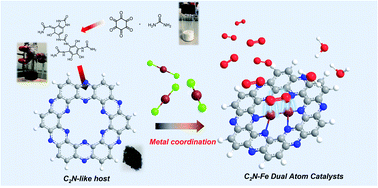
J. Mater. Chem. A, 2022,10, 6023-6030
https://doi.org/10.1039/D1TA09560A
Computational screening of single-atom alloys TM@Ru(0001) for enhanced electrochemical nitrogen reduction reaction
Single atom alloys (SAAs) based on TM doped Ru(0001) were investigated for their nitrogen reduction activity using density functional modelling. V@Ru(0001) was found to exhibit a low negative limiting potential and the TOF of the V@Ru(0001) catalyst was shown to be high.
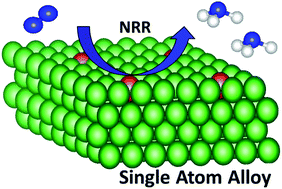
J. Mater. Chem. A, 2022,10, 6204-6215
https://doi.org/10.1039/D1TA08246A
Impact of the dopant-induced ensemble structure of hetero-double atom catalysts in electrochemical NH3 production
Compared to Ru single atom catalyst, hetero-RuM (M = Fe, Os, and Ir) double atom catalysts showed improved N2RR activity with the help of dxz and dxy bonding orbital, caused by strain, dopant and configurational effects.
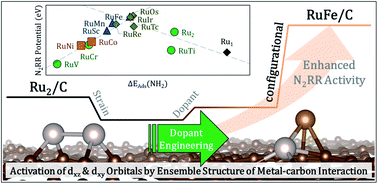
J. Mater. Chem. A, 2022,10, 6216-6230
https://doi.org/10.1039/D1TA08358A
Photocatalytic degradation of methylene blue (MB) with Cu1–ZnO single atom catalysts on graphene-coated flexible substrates
Single-atom catalyst of Cu1@ZnO/GPET synthesized via hydrothermal method is shown to exhibit excellent photocatalytic activity towards the degradation of methylene blue solution due to high electron–hole separation efficiency.
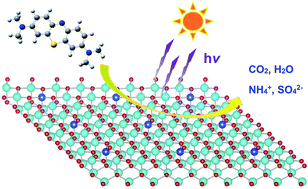
J. Mater. Chem. A, 2022,10, 6231-6241
https://doi.org/10.1039/D1TA09954J
Modeling the roles of rigidity and dopants in single-atom methane-to-methanol catalysts
Computational studies of structural and catalytic properties of single atom catalysts suggest they are attractive candidates for methane-to-methanol conversion.
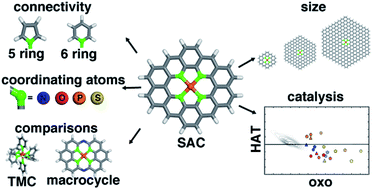
J. Mater. Chem. A, 2022,10, 6193-6203
https://doi.org/10.1039/D1TA08502F
Multiscale porous single-atom Co catalysts for epoxidation with O2
The single-atom Co anchored on N-doped carbon supports with a multiscale porous structure has been successfully constructed for the epoxidation of cyclooctene with 95% yield of 1,2-epoxycycloheptane at 140 °C and 0.5 MPa O2.
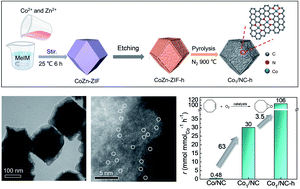
J. Mater. Chem. A, 2022,10, 6016-6022
https://doi.org/10.1039/D1TA09227H
C3 production from CO2 reduction by concerted *CO trimerization on a single-atom alloy catalyst
Embedding Ag single atoms onto densely arrayed Cu nanopyramids could optimize the *CO adsorption strength toward direct propanediol production via a one-step concerted *CO trimerization mechanism.
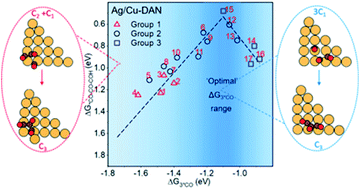
J. Mater. Chem. A, 2022,10, 5998-6006
https://doi.org/10.1039/D1TA09608G
Single-atom catalysts on supported silicomolybdic acid for CO2 electroreduction: a DFT prediction
Single-atom catalysts on supported silicomolybdic acid for CO2 electroreduction.

J. Mater. Chem. A, 2022,10, 6178-6186
https://doi.org/10.1039/D1TA08285J
Construction of single-atom copper sites with low coordination number for efficient CO2 electroreduction to CH4
A simple and effective plasma-activated strategy is employed to synthesize a MOF-based single-atom copper catalyst, which contains abundant low-coordinated copper sites for high-performance CO2 electroreduction to CH4.

J. Mater. Chem. A, 2022,10, 6187-6192
https://doi.org/10.1039/D1TA08494A
Atomically-dispersed NiN4–Cl active sites with axial Ni–Cl coordination for accelerating electrocatalytic hydrogen evolution
The NiN4–Cl SAs/N–C electrocatalyst consisting of NiN4–Cl active sites with axial Ni–Cl coordination was synthesized. The axial Cl-coordination modulates the electronic configuration of Ni–N4 sites and enhances the interaction of Ni–H efficiently.

J. Mater. Chem. A, 2022,10, 6007-6015
https://doi.org/10.1039/D1TA08287F
A polyoxometalate cluster-based single-atom catalyst for NH3 synthesis via an enzymatic mechanism
The proposed new non-noble-metal Mo1/PMASAC is potentially more efficient and more selective than the current best Mo/BN and FeN3/embedded graphene SAC, and the preferred mechanism is an enzymatic pathway.
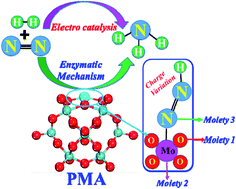
J. Mater. Chem. A, 2022,10, 6165-6177
https://doi.org/10.1039/D1TA07903D
SnO2-supported single metal atoms: a bifunctional catalyst for the electrochemical synthesis of H2O2
SnO2 supported single metal atoms offer unique bifunctional catalyst materials for electrochemical synthesis of hydrogen peroxide via 2e-ORR and 2e-WOR.

J. Mater. Chem. A, 2022,10, 6115-6121
https://doi.org/10.1039/D1TA07562D
Redispersion strategy for high-loading carbon-supported metal catalysts with controlled nuclearity
Layer-by-layer redispersion of high-loading carbon-supported metal nanoparticles into small clusters and single atoms via cyclic alternating exposure to C2H2 and HCl atmospheres.
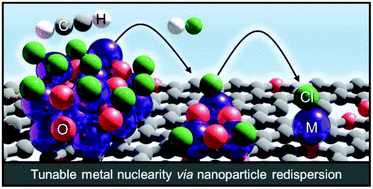
J. Mater. Chem. A, 2022,10, 5953-5961
https://doi.org/10.1039/D1TA09238C
Inducing atomically dispersed Cl–FeN4 sites for ORRs in the SiO2-mediated synthesis of highly mesoporous N-enriched C-networks
A hierarchically porous N/C-network containing atomically dispersed Cl–FeN4 nuclei as superior ORR electrocatalysts in an alkaline environment.
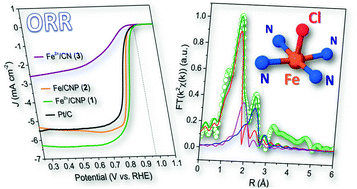
J. Mater. Chem. A, 2022,10, 6153-6164
https://doi.org/10.1039/D1TA09519F
Europium single atom based heterojunction photocatalysts with enhanced visible-light catalytic activity
By taking advantage of the unique advantages of Eu3+ single atom catalysis and the II-type heterojunction in the field of photocatalytic reduction, a Eu3+ single atom doped CdS/InVO4 II-type heterojunction was successfully constructed.
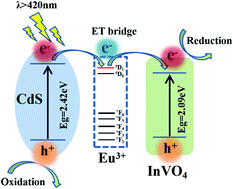
J. Mater. Chem. A, 2022,10, 5990-5997
https://doi.org/10.1039/D1TA08253A
Coupling isolated Ni single atoms with sub-10 nm Pd nanocrystals embedded in porous carbon frameworks to boost oxygen electrocatalysis for Zn–air batteries
Atomically dispersed Ni sites are coupled with sub-5 nm Pd nanocrystals embedded in carbon frameworks to form a bifunctional catalyst, which could serve as a highly efficient catalyst for the ORR, OER, and Zn–air batteries.
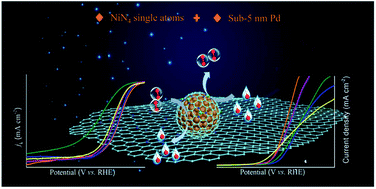
J. Mater. Chem. A, 2022,10, 6086-6095
https://doi.org/10.1039/D1TA06897K
Au single atom-anchored WO3/TiO2 nanotubes for the photocatalytic degradation of volatile organic compounds
Anchoring Au atoms on WO3/TiO2 nanotubes by a simple two-step electrochemical approach significantly improved the photocatalytic degradation of toluene, due to the enhanced transfer and separation of photogenerated carriers and adsorption.

J. Mater. Chem. A, 2022,10, 6078-6085
https://doi.org/10.1039/D1TA08143H
Theoretical investigation on hydrogenation of dinitrogen triggered by singly dispersed bimetallic sites
By first-principles calculations, the singly dispersed bimetallic site, Pd1Co4/CoOx SCC, is proposed to exhibit superior charge buffer capacity towards thermal dinitrogen hydrogenation based on a superimposed evaluation strategy.

J. Mater. Chem. A, 2022,10, 6146-6152
https://doi.org/10.1039/D1TA08350C
π-Adsorption promoted electrocatalytic acetylene semihydrogenation on single-atom Ni dispersed N-doped carbon
As a novel electrocatalyst for acetylene semihydrogenation, single-atom nickel dispersed N-doped carbon exhibits a high acetylene conversion of 97.4%, which are attributed to weak π-adsorption of ethylene on individual Ni sites.
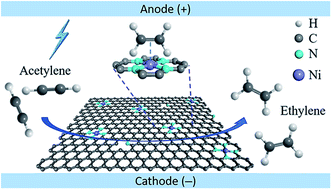
J. Mater. Chem. A, 2022,10, 6122-6128
https://doi.org/10.1039/D1TA08002D
Hybrid palladium nanoparticles and nickel single atom catalysts for efficient electrocatalytic ethanol oxidation
A Pd nanoparticle@Ni single-atomic catalyst (SAC) was developed for electrocatalytic ethanol oxidation. The Pd nanoparticles served as catalytic sites of ethanol, and the produced CO species adsorbed on Pd were electrochemically oxidized by Ni SAC.
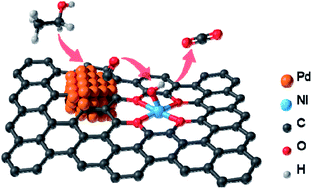
J. Mater. Chem. A, 2022,10, 6129-6133
https://doi.org/10.1039/D1TA08518B
A MnOx enhanced atomically dispersed iron–nitrogen–carbon catalyst for the oxygen reduction reaction
A MnOx-assisted strategy is proposed to improve the oxygen reduction activity and stability of Fe–N–C single-atom catalysts (SACs) by regulating the electron structure and reducing the side effects of the Fenton reaction.
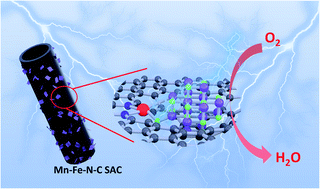
J. Mater. Chem. A, 2022,10, 5981-5989
https://doi.org/10.1039/D1TA07219F
CuII/CuI decorated N-doped carbonaceous electrocatalysts for the oxygen reduction reaction
Copper- and nitrogen-doped carbonaceous materials, obtained by a simple synthetic procedure are highly efficient and fast catalysts for the oxygen reduction reaction. It is shown, that Cu(I) containing materials perform with faster reaction kinetics.

J. Mater. Chem. A, 2022,10, 6107-6114
https://doi.org/10.1039/D1TA09459A
In situ TEM visualization of single atom catalysis in solid-state Na–O2 nanobatteries
In situ TEM observation and DFT calculation provide an atomic-scale understanding of the electrocatalysis mechanism of single-atom catalysts in an Na–O2 nanobattery, where single-atomic Co sites facilitate the formation/decomposition of Na2O2.
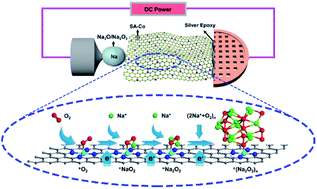
J. Mater. Chem. A, 2022,10, 6096-6106
https://doi.org/10.1039/D1TA08080F
Self-driven dual hydrogen production system based on a bifunctional single-atomic Rh catalyst
A self-powered dual hydrogen production system constructed by combining a Zn–H2 battery and an overall hydrazine splitting unit with Rh single atoms supported on oxygen-functionalized Ti3C2Ox bifunctional catalyst achieves a promising H2 generation rate of 45.77 mmol h−1.

J. Mater. Chem. A, 2022,10, 6134-6145
https://doi.org/10.1039/D1TA07375C
Structural and electronic insight into the effect of indium doping on the photocatalytic performance of TiO2 for CO2 conversion
In-doping induces electronic modifications in TiO2 leading to an increase in the CO2 photoreduction selectivity towards CH4.
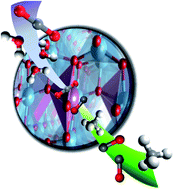
J. Mater. Chem. A, 2022,10, 6054-6064
https://doi.org/10.1039/D1TA08347C
High-loading metal atoms on graphdiyne for efficient nitrogen fixation to ammonia
A new graphdiyne-based manganese atomic catalyst (MnSA/GDY) was reported for efficient electrocatalytic nitrogen reduction to ammonia. It achieves a high ammonia yield rate and Faradaic efficiency at ambient temperatures and pressures.

J. Mater. Chem. A, 2022,10, 6073-6077
https://doi.org/10.1039/D1TA08241H
Single Mo atoms paired with neighbouring Ti atoms catalytically decompose ammonium bisulfate formed in low-temperature SCR
We developed a TiO2-supported single-atom Mo catalyst (Mo1/TiO2) where single Mo atoms paired with the neighboring surface Ti atoms function as Mo–Ti acid–base dual sites, realizing the decomposition of ABS at ∼225 °C.

J. Mater. Chem. A, 2022,10, 6065-6072
https://doi.org/10.1039/D1TA08269H
Impact of Ir modification on the durability of FeNC catalysts under start-up and shutdown cycle conditions
Ir modification of FeNC catalysts improves the durability of the catalysts, but causes electronic changes that are disadvantageous for the activity.
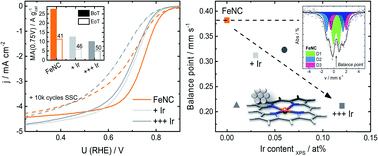
J. Mater. Chem. A, 2022,10, 6038-6053
https://doi.org/10.1039/D1TA04668C
Zinc/graphitic carbon nitride co-mediated dual-template synthesis of densely populated Fe–Nx-embedded 2D carbon nanosheets towards oxygen reduction reactions for Zn–air batteries
Densely populated single-atom Fe–Nx-embedded carbon nanosheets (SAs-Fe/N-CNSs) synthesized by a Zn/g-C3N4-mediated dual-template strategy with excellent performance on ORRs and Zn–air batteries.
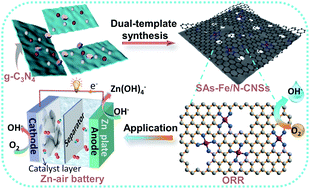
J. Mater. Chem. A, 2022,10, 5971-5980
https://doi.org/10.1039/D1TA08007E
Enhancing the inherent catalytic activity and stability of TiO2 supported Pt single-atoms at CeOx–TiO2 interfaces
An advanced strategy for practical application of Pt-SA catalysts.

J. Mater. Chem. A, 2022,10, 5942-5952
https://doi.org/10.1039/D1TA08059H
Platinum-complexed phosphorous-doped carbon nitride for electrocatalytic hydrogen evolution
Platinum is atomically dispersed within P-doped C3N4 forming Pt–N/P/Cl coordination interactions, and exhibits markedly enhanced electrocatalytic activity towards the hydrogen evolution reaction in acidic media, as compared to the P-free counterpart.
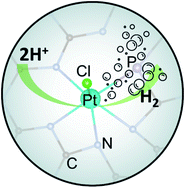
J. Mater. Chem. A, 2022,10, 5962-5970
https://doi.org/10.1039/D1TA06240A
Catalytic conversion of NO and CO into N2 and CO2 by rhodium–aluminum oxides in the gas phase
The catalytic conversion of NO and CO into N2 and CO2 mediated by gas-phase rhodium-aluminum oxides (RhAlO0–3 and RhAl2O1–4) has been identified. The polarized Rh–Al bond in the reactive systems is required to catalyze NO reduction by CO.
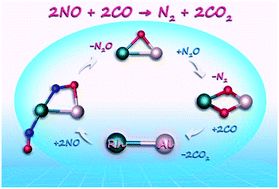
J. Mater. Chem. A, 2022,10, 6031-6037
https://doi.org/10.1039/D1TA04911A
About this collection
Single-atom catalysts (SACs) with isolated metal atoms dispersed on solid supports have emerged as a new frontier in catalysis science owing to their great potential to bridge the gap between heterogeneous and homogeneous catalysis. The active centers of this new class of materials possess unique electronic structure and unsaturated coordination environments, which have been proven to improve catalytic activity in a variety of reactions. Moreover, the homogeneity in the active sites and geometric structure of SACs, which show similarities to their homogeneous catalyst analogs, afford them a great potential to enhance selectivity because of similar spatial and electronic interactions to substrates.
To this end, this themed collection of Journal of Materials Chemistry A aims to provide a platform for recent developments in this rapidly evolving field of SACs including synthetic strategies, selectivity regulation, theoretical understanding of the catalytic activity and stability, single-atom alloy, support effect, and novel applications in electrocatalysis, photocatalysis, photoelectrocatalysis, selective hydrogenation, and other fields. We hope that readers find this themed collection informative and useful. Guest Edited by Zhiqun Lin (Georgia Institute of Technology, USA), Maria Escudero Escribano (University of Copenhagen, Denmark) and Jun Li (Tsinghua University, China).